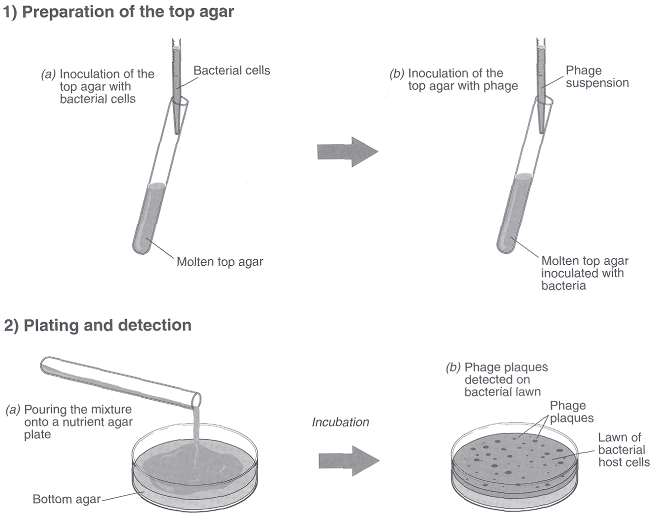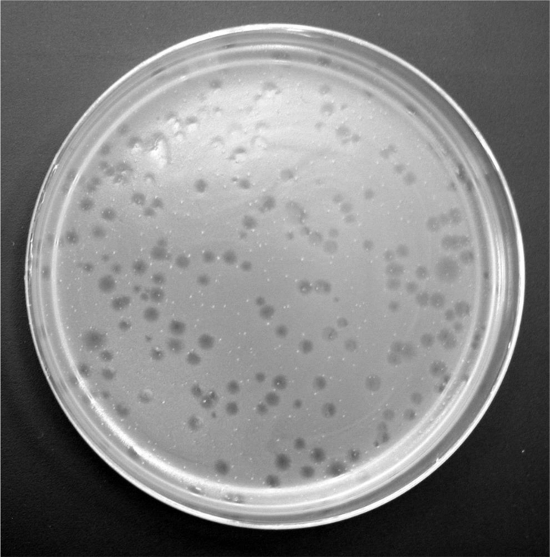環境試料中のバクテリオファージの検出
概要
ソース: ドクターペッパー イアン博士チャールズ Gerba - アリゾナ大学所
示す著者: アレックス Wassimi
ウイルスは、真核生物と原核生物に感染する生物学的実体のユニークなグループです。代謝能力を持たず、宿主細胞の内部自己組み立てるウイルスの部品を生産する宿主の代謝に依存して、レプリケートするために義務づける寄生虫です。
ウイルスが極微、光学顕微鏡、電子顕微鏡のより高い解像度でのみ表示で閲覧するのには小さすぎます。ウイルスの粒子は DNA や RNA、蛋白質の亜単位または capsomers から成るキャプシドと呼ばれるタンパク質のコートに囲まれた核酸のゲノムから成っています。いくつかのより複雑なウイルスのキャプシドはさらに脂質エンベロープに囲まれた、スパイクのような表面の付属肢や尾があります。
人間や動物の腸管に感染するウイルスは、腸管系ウイルスと呼ばれます。彼らは、糞便中に排泄され、排水から分離することができます。細菌に感染するウイルス、バクテリオファージ、として知られている、大腸菌に感染するものは coliphages (図 1) をいいます。大腸菌の細菌のファージは、大腸菌が見つかったどこでも発見されています。

図 1。ファージ T2。
手順
- 下水やファージを含む水のサンプルを取得します。
- サンプル 1:10 と 1: 100 Tris バッファーを使用して希釈します。Tris バッファー 9 mL に文化の 1.0 mL を転送し、2 番目の十倍の希薄によってこれを行います。
- スチームバスやオートクレーブにそれらを置くことによって軟寒天培地 (0.7% 寒天またはトリプチ豆乳寒天培地 3 mL チューブあたり) の 3 つの管を溶かします。
- 45 ° c. に調整する寒天培地の温度を許可するように 15 分間 45-48 ° c の水浴の寒天を配置します。
- 最初のチューブにエシェリヒア属大腸菌1と原液のサンプル 1 mL のログ相スープ文化の 1 mL を追加します。
- 水浴と軽く 2-3 s の懸濁液を混合する手の間ロックからチューブを削除します。
- ペーパー タオルの管から水を拭くし、下の寒天 (通常寒天またはトリプチ豆乳寒天) を含む事前に準備されたペトリ皿に寒天を注ぐ。
- すぐに上の寒天を広めるためプレートを回転させます。
結果
申請書と概要
タグ
スキップ先...
このコレクションのビデオ:

Now Playing
環境試料中のバクテリオファージの検出
Environmental Microbiology
40.6K 閲覧数

土壌中の水分の定量
Environmental Microbiology
358.9K 閲覧数

無菌環境科学
Environmental Microbiology
126.2K 閲覧数

環境ソースから細菌のグラム染色
Environmental Microbiology
99.9K 閲覧数

連絡先を介して可視化の土壌微生物スライド法と顕微鏡
Environmental Microbiology
42.1K 閲覧数

糸状菌
Environmental Microbiology
57.1K 閲覧数

細菌のコロニーからコミュニティの DNA の抽出
Environmental Microbiology
28.8K 閲覧数

ポリメラーゼ連鎖反応およびゲル電気泳動法と環境微生物の検出
Environmental Microbiology
44.5K 閲覧数

RT-PCR 法を用いた環境試料の RNA 解析
Environmental Microbiology
40.3K 閲覧数

環境微生物やウイルスを使用しての qPCR の定量化
Environmental Microbiology
47.8K 閲覧数

指標生物による水質分析
Environmental Microbiology
29.4K 閲覧数

ろ過による水試料からの糞便細菌の分離
Environmental Microbiology
39.2K 閲覧数

養殖および土壌試料からの細菌を列挙します。
Environmental Microbiology
183.8K 閲覧数

細菌の成長曲線の解析と環境応用
Environmental Microbiology
295.6K 閲覧数

藻類培養手法を介して列挙
Environmental Microbiology
13.7K 閲覧数
Copyright © 2023 MyJoVE Corporation. All rights reserved

